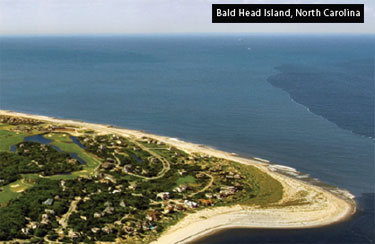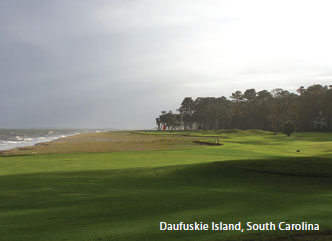A remote island off the coast of South Carolina once was home to a herd of goats and a man and his wife, two people who, apparently tired, afraid or simply fed up with modern civilization, chose to live a life devoid of electricity,  running water, traffic, regular paychecks and everything else that was making life more complicated and infinitely noisier for their neighbors on the mainland.
running water, traffic, regular paychecks and everything else that was making life more complicated and infinitely noisier for their neighbors on the mainland.
Though it is only a few hundred yards from the Isle of Palms, a popular beach community just northeast of Charleston, Goat Island remains a remote outpost surrounded by water, living proof that there still are places along the East Coast of the United States where you can close your eyes and at least pretend that an ocean separates you and the rest of the world.
There are no roads to Goat Island; you can reach it only by sea or air, a trait it shares with several other islands along the Carolina coast. They range from Daufuskie Island at the southern tip of Beaufort County in South Carolina to Ocracoke Island, well off the coast of central North Carolina, and each offers its own unique opportunities for fun and relaxation. But as diverse as these five islands are, they also are similar in one important aspect.  Surrounded by water, they engulf their residents and visitors in an aura of serenity, a feeling of tranquility unavailable on islands connected to the rest of the world by magnificent bridges that soar to the sky or even by one-lane, wooden structures that barely rise above the swamp.
Surrounded by water, they engulf their residents and visitors in an aura of serenity, a feeling of tranquility unavailable on islands connected to the rest of the world by magnificent bridges that soar to the sky or even by one-lane, wooden structures that barely rise above the swamp.
It matters not how close an island is to the mainland. If you need a boat to get there, it might as well be a thousand miles away.
Take, for instance, Daufuskie Island, South Carolina. Located across the Calibogue Sound from Hilton Head Island and separated from the mainland on the west by the Intracoastal Waterway, it would be within easy driving distance of historic Savannah if driving were an option. It’s not. If you want to go anywhere from Daufuskie Island, you must ride the ferry to Hilton Head first.
With a total surface area of around eight square miles, Daufuskie’s fulltime population is just above 400. The five-mile-long island features a resort, a few residential communities, a smattering of other home sites and a large, undeveloped tract of land that is home to a wide range of plant and animal life, including the fox squirrel and the American bald eagle. A large chuck of the island is dedicated to the game of golf. The Bloody Point Course was designed by Tom Weiskopf and Jay Morrish, while the Melrose Course is a creation of Jack Nicklaus. Rees Jones built both Haig Point layouts, the Signature Course and the Osprey Course.
Daufuskie Island has earned its place in history and in fiction. The site of a battle during the Yamasee War in the early 18th century, it was the home of a large population of descendants of freed slaves for many years after the Civil War. And in 1972, Pat Conroy wrote “The Water Is Wide,” a fictional account of his time as a teacher on Daufuskie Island – Yamacraw Island in the book.
Further up the coast, within shouting distance of Charleston, is tiny Goat Island, the exclusive home of the Goat Man, his wife and their goats for three decades. In 1931, Henry and Blanche Holloway claimed the island as their own, living off the land and, eventually, off handouts from passing boaters. They both passed away in the early 1960s.
Despite its proximity to the Isle of Palms, Goat Island is still separated from the rest of the world, accessible only by boat, without automobiles and sparsely populated.
Nearby Dewees Island has attracted more residents – but not that many more. Once used for hunting by the R.J. Reynolds family, the privately-owned island is now a testament to man’s efforts to co-exist with nature.
Accessible only by boat – a ferry runs regularly to and from the Isle of Palms – Dewees Island was purchased by a group of local investors in 1970. They merged with another group 22 years later, forming the Island Preservation Partnership, which is now responsible for making sure man and nature treat each other with mutual respect. No more than 150 homes will be built on the island, only 7,500 square feet of each lot can be disturbed by construction and homes can’t exceed 5,000 square feet. All homeowners enjoy a view of either the Atlantic Ocean, the Intracoastal Waterway or Lake Timicau.
Dewees is no Goat Island, however. Residents have access to modern conveniences such as electricity and telephone service, through underground lines, and the island has a pool, tennis courts, a clubhouse and guest suites. But you won’t find paved roads, grocery stores, restaurants or gas stations on Dewees Island. The main modes of transportation are riding in golf carts and walking.
Like Dewees, there really is no need for gas stations on Bald Head Island, North Carolina, because there are no cars. Residents, around 300 of them, get around in golf carts, on bicycles or using their own two feet.
They can get to the island, located on the east side of the Cape Fear River in Brunswick County, on a ferry that leaves from nearby Southport.
Bald Head has much to offer in the way of recreational activities, including boating, hiking, swimming, bird-watching, 14 miles of beautiful beaches and one of North Carolina’s most spectacular golf venues. The Bald Head Island Club’s course, built by George Cobb amid dunes, lagoons and a maritime forest and alongside the Atlantic Ocean, is inhabited by herons, egrets, foxes and alligators.
Like Daufuskie Island, Bald Head Island has a place in history and fiction. It was home to the British Fort George during the American Revolution and to the Confederate Fort Holmes during the Civil War. “Old Baldy,” North Carolina’s oldest lighthouse, has been around since 1817 but is no longer in use.
Two movies have been at least partially filmed at Bald Head: “Weekend at Bernie’s” and “The Butcher’s Wife.” Ocracoke Island, part of North Carolina’s Outer Banks and the Cape Hatteras National Seashore, is far from the mainland, but, unlike some remote islands along the Southeast coast, welcomes its visitors in a big way, offering a wide range of hotels, motels, and bed and breakfasts and several festivals throughout the year. The only way visitors, and locals, for that matter, can reach the island is by ferry – a 40-minute journey from Hatteras Island or from Swan Quarter on the mainland or Cedar Island – private boat or small airplane. Automobiles are permitted on Ocracoke Island, but there is only one paved two-lane road, running the length of the island.
Visitors flock to the island for the annual Ocrafolk Festival, held the first weekend in June, to enjoy music, listen to storytellers and find out what local artisans and craftspeople have to offer. The Fourth of July is another big day on the island, with a parade, entertainment and a visit from Blackbeard, the infamous pirate killed in a naval battle at Ocracoke Island in 1718. Islanders and visitors close out the year with the Watermen’s Oyster Roast, held the last weekend of December, with local oysters, steamed shrimp and musical entertainment. The Ocracoke Business & Civic Association encourages visitors to consider the island for other events, including family reunions, company retreats and weddings.
Like other islands along the coast, Ocracoke has played a role in the history of the United States. Once part of a busy trade route, it was a destination for ships too large to navigate the shallow Pamlico Sound. It also served as a convenient haven for pirates, including, of course, Blackbeard, and was in a strategic location for shipping during the American Revolution and the Civil War.



